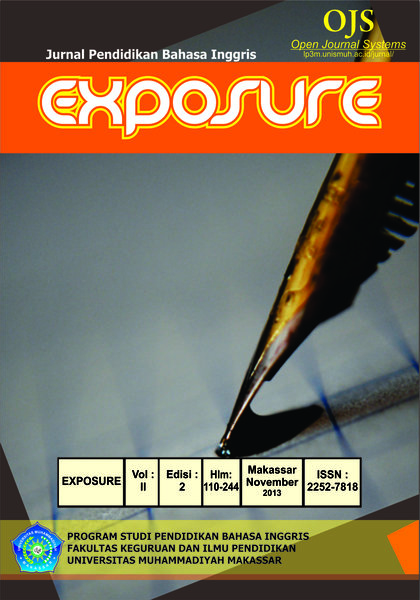THE USE OF FAIES (FIRST AID IN ENGLISH SYSTEM) METHOD TO DEVELOP THE STUDENTS’ WRITING ABILITY
DOI:
https://doi.org/10.26618/exposure.v2i2.792Abstrak
This research aimed to find out the improvement of the students’ writing ability in term of grammar covering simple past tense and past continuous tense and vocabulary covering verb and noun, especially in recount text at the eighth-grade students of SMP Unismuh Makassar. The researcher used a classroom action research (CAR) which was conducted in two cycles where each cycle consisted of four meetings and the application consisted of four steps namely planning, action, observation, and reflection. The technique of collecting data is writing test and observation and technique of data analysis is quantitative. The number of the research subject was 26 students in class VIIIB and all the students were male. The research findings indicated that using FAIES method could improve the students writing ability in terms of grammar and vocabulary. It was proved by the students’ mean score in the test of cycle II, the result was (75.25) which increased 15.15 % from the cycle I mean score (60.1). It was highly increased from a diagnostic test (D – test) mean score (48.2). The students’ achievement in cycle II indicated that it had met the researcher score target (75) where the classification of students’ score was 4 students got excellent score where the percentage was 15.4%, 11 students got good score where the percentage was 42.3%, 10 students got fair score where the percentage was 38.5% and 1 student got poor score where the percentage was 3.8%. Based on the findings of the research above, the researcher concluded that FAIES method were successful in improving the students’ writing ability covering grammar and vocabulary for recount text at the eighth-grade students of SMP Unismuh Makassar class VIIIB .
Keyword: FAIES, develop, writing, ability
Referensi
Atkinson, Dwigt. 2003. L2 Writing in the Post-Process Era. Minato-ku. Tokyo.
Badger, Richard, and White, Goodith. 2000. A process genre approach for teaching writing. Oxford University Press.Oxford.
Basri D, M. 2010. Fundamentals of Research Methodology. Makassar.
Byrne, D. 1990. Teaching Writing Skills. London and New York: Longman Handbooks for Language Teacher.
Cook, Guy. 1990. Discourse. Oxford University Press. Oxford.
Crystal, D. 2000. English As Global Language. Cambridge: Cambridge University Press.
Flowerdew, John. 1993. An educational, or process, approach to the teaching of professional genres. Oxford University Press. Oxford.
Fterniati, Anna and Spinthourakis Athena, Julia. 2006. Implementing a Text Oriented Approach to Effect Students’ Textual Competence. Common Ground. http://www.learning-journal.com
Harmer, J. 1991. The Practice of English Language Teaching. London and New York: Longman Publishing, New York.
Hasan, Kamrul and Akhand, Moniruzzaman. 2010. Approaches to Writing in EFL / ESL Context Balancing Product and Process in Writing Class at Tertiary Level. http://www.Journal-NELTA.com. Vol. 15. No. 1-2.
Hossein H, 2012. A comparative study of the product, process, the post-process approach in Iranian EFL students’ writing skill. Islamic Azad University. Iran.
Huddleston, Rodney. 1988. English Grammar. Cambridge University Press. Cambridge.
Hyland, Ken. 2002. Genre: Language, Context, and Literacy. Cambridge University Press. Cambridge.
Millar, Diane. 2011. Promoting Genre Awareness in the EFL Classroom. English Teaching Forum. Senegal.
Oshima, Alice, and Hogue, Ann.1997.Introduction to Academic Writing. Longman.
Yan, Guo. 2005. A process genre model for teaching writing. English Teaching Forum (ETF). China.
Zaree, Abbas. 2008. The Effect of Teaching Genre Moves on EFL Learners’ Performance in Letter Writing. Kashan University. Kashan.
Unduhan
Diterbitkan
Terbitan
Bagian
Lisensi
Authors who publish with this journal agree to the following terms:
In order to assure the highest standards for published articles, a peer review policy is applied. In pursue of the compliance with academic standards, all parties involved in the publishing process (the authors, the editors and the editorial board and the reviewers) agree to meet the responsibilities stated below in accordance to the Journal publication ethics and malpractice statement.
Duties of Authors:
- The author(s) warrant that the submitted article is an original work, which has not been previously published, and that they have obtained an agreement from any co-author(s) prior to the manuscript’s submission;
- The author(s) should not submit articles describing essentially the same research to more than one journal;
- The authors(s) make certain that the manuscript meets the terms of the Manuscript Submission Guideline regarding appropriate academic citation and that no copyright infringement occurs;
- The authors(s) should inform the editors about any conflict of interests and report any errors they subsequently, discover in their manuscript.
Duties of Editors and the Editorial Board:
- The editors, together with the editorial board, are responsible for deciding upon the publication or rejection of the submitted manuscripts based only on their originality, significance, and relevance to the domains of the journal;
- The editors evaluate the manuscripts compliance with academic criteria, the domains of the journal and the guidelines;
- The editors must at all times respect the confidentiality of any information pertaining to the submitted manuscripts;
- The editors assign the review of each manuscript to two reviewers chosen according to their domains of expertise. The editors must take into account any conflict of interest reported by the authors and the reviewers.
- The editors must ensure that the comments and recommendations of the reviewers are sent to the author(s) in due time and that the manuscripts are returned to the editors, who take the final decision to publish them or not.
Authors are permitted and encouraged to post online a pre-publication manuscript (but not the Publisher’s final formatted PDF version of the Work) in institutional repositories or on their Websites prior to and during the submission process, as it can lead to productive exchanges, as well as earlier and greater citation of published work (see The Effect of Open Access). Any such posting made before acceptance and publication of the Work shall be updated upon publication to include a reference to the Publisher-assigned DOI (Digital Object Identifier) and a link to the online abstract for the final published Work in the Journal.

